BA Leadership: Leading and Implementing Workplace Change at Tesco PLC
VerifiedAdded on 2022/09/10
|23
|6160
|23
Report
AI Summary
This report examines Tesco PLC's history, external factors impacting its performance, and strategic changes driven by leadership. It analyzes the company's evolution, including its expansion, acquisitions, and adaptation to market trends. The report delves into Tesco's leadership styles, particularly the participative or democratic approach, and its influence on change management. It explores how organizational culture affects the implementation of change programs, considering the impact of political, economic, social, technological, environmental, and legal factors. The report also discusses Tesco's corporate social responsibility initiatives and its response to changing consumer behaviors and preferences, including the adoption of technologies like RFID and online shopping. Finally, it highlights key milestones in Tesco's history and the leadership transitions that shaped its growth and adaptation to a dynamic retail landscape.

Running head: LEADING AND IMPLEMENTING WORKPLACE CHANGE
Leading and implementing workplace change
Name of the Student
Name of the University
Author Note
Leading and implementing workplace change
Name of the Student
Name of the University
Author Note
Paraphrase This Document
Need a fresh take? Get an instant paraphrase of this document with our AI Paraphraser

1LEADING AND IMPLEMENTING WORKPLACE CHANGE
Executive Summary
The report has been prepared to discuss Tesco Plc one of the most renowned retail stores of
the United Kingdom. The report gives detailed information regarding its history and how
external changes have affected the company. It also provides a clear picture of the strategic
changes which the company undertook and the leadership style followed by the company
over the years. The organizational cultural impact on the company’s change management
programme has been discussed as well in the report.
Executive Summary
The report has been prepared to discuss Tesco Plc one of the most renowned retail stores of
the United Kingdom. The report gives detailed information regarding its history and how
external changes have affected the company. It also provides a clear picture of the strategic
changes which the company undertook and the leadership style followed by the company
over the years. The organizational cultural impact on the company’s change management
programme has been discussed as well in the report.
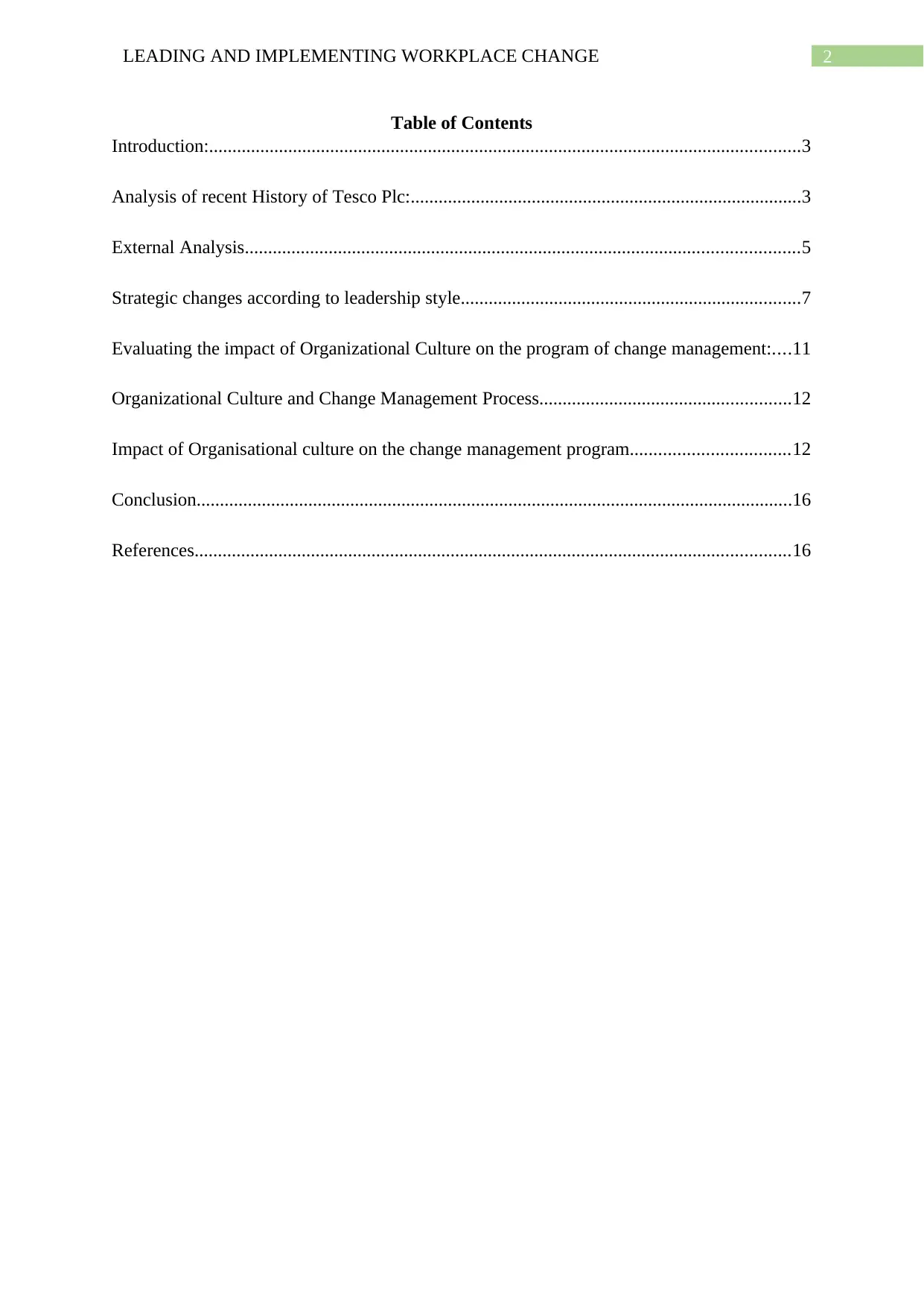
2LEADING AND IMPLEMENTING WORKPLACE CHANGE
Table of Contents
Introduction:...............................................................................................................................3
Analysis of recent History of Tesco Plc:....................................................................................3
External Analysis.......................................................................................................................5
Strategic changes according to leadership style.........................................................................7
Evaluating the impact of Organizational Culture on the program of change management:....11
Organizational Culture and Change Management Process......................................................12
Impact of Organisational culture on the change management program..................................12
Conclusion................................................................................................................................16
References................................................................................................................................16
Table of Contents
Introduction:...............................................................................................................................3
Analysis of recent History of Tesco Plc:....................................................................................3
External Analysis.......................................................................................................................5
Strategic changes according to leadership style.........................................................................7
Evaluating the impact of Organizational Culture on the program of change management:....11
Organizational Culture and Change Management Process......................................................12
Impact of Organisational culture on the change management program..................................12
Conclusion................................................................................................................................16
References................................................................................................................................16
⊘ This is a preview!⊘
Do you want full access?
Subscribe today to unlock all pages.

Trusted by 1+ million students worldwide
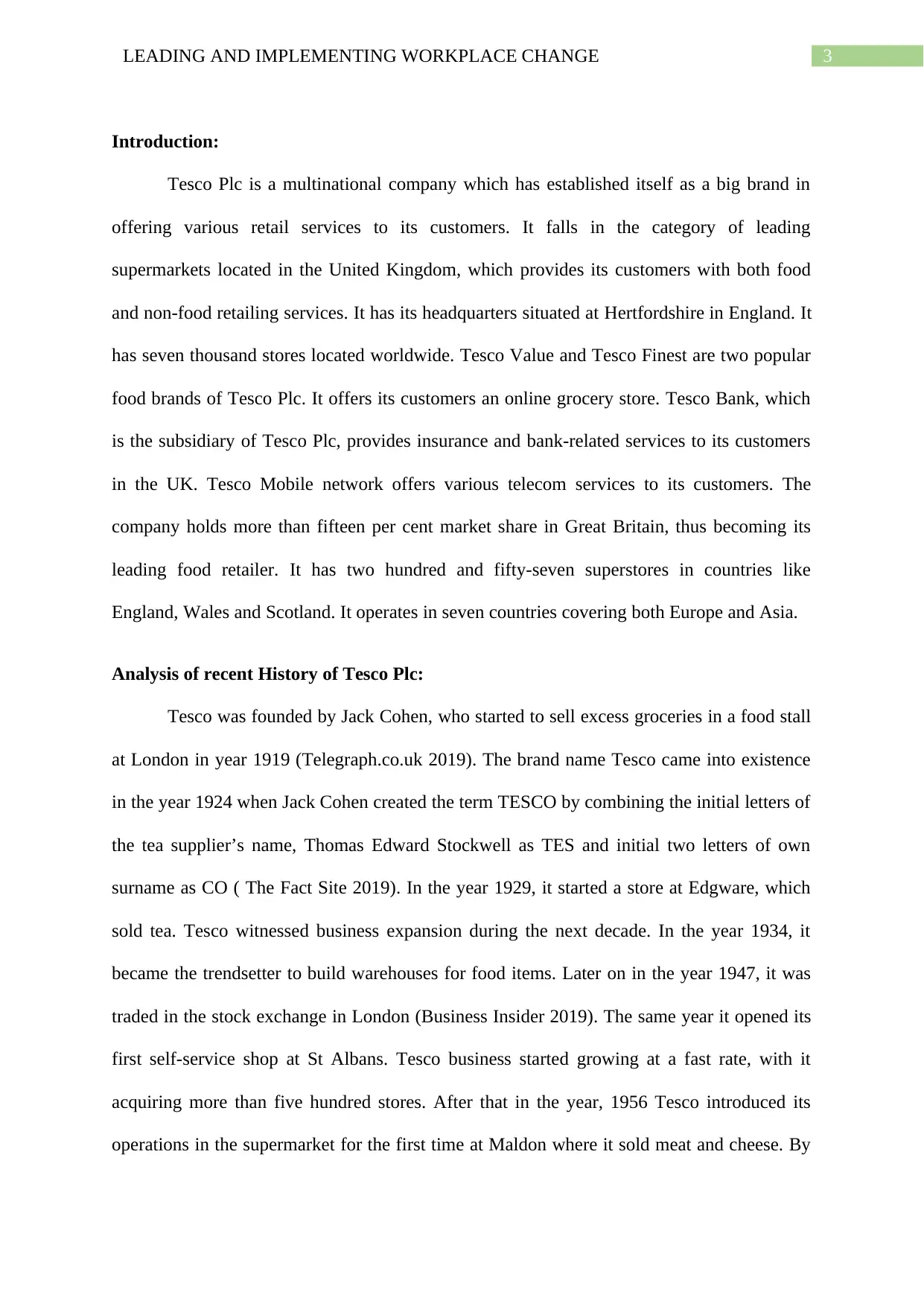
3LEADING AND IMPLEMENTING WORKPLACE CHANGE
Introduction:
Tesco Plc is a multinational company which has established itself as a big brand in
offering various retail services to its customers. It falls in the category of leading
supermarkets located in the United Kingdom, which provides its customers with both food
and non-food retailing services. It has its headquarters situated at Hertfordshire in England. It
has seven thousand stores located worldwide. Tesco Value and Tesco Finest are two popular
food brands of Tesco Plc. It offers its customers an online grocery store. Tesco Bank, which
is the subsidiary of Tesco Plc, provides insurance and bank-related services to its customers
in the UK. Tesco Mobile network offers various telecom services to its customers. The
company holds more than fifteen per cent market share in Great Britain, thus becoming its
leading food retailer. It has two hundred and fifty-seven superstores in countries like
England, Wales and Scotland. It operates in seven countries covering both Europe and Asia.
Analysis of recent History of Tesco Plc:
Tesco was founded by Jack Cohen, who started to sell excess groceries in a food stall
at London in year 1919 (Telegraph.co.uk 2019). The brand name Tesco came into existence
in the year 1924 when Jack Cohen created the term TESCO by combining the initial letters of
the tea supplier’s name, Thomas Edward Stockwell as TES and initial two letters of own
surname as CO ( The Fact Site 2019). In the year 1929, it started a store at Edgware, which
sold tea. Tesco witnessed business expansion during the next decade. In the year 1934, it
became the trendsetter to build warehouses for food items. Later on in the year 1947, it was
traded in the stock exchange in London (Business Insider 2019). The same year it opened its
first self-service shop at St Albans. Tesco business started growing at a fast rate, with it
acquiring more than five hundred stores. After that in the year, 1956 Tesco introduced its
operations in the supermarket for the first time at Maldon where it sold meat and cheese. By
Introduction:
Tesco Plc is a multinational company which has established itself as a big brand in
offering various retail services to its customers. It falls in the category of leading
supermarkets located in the United Kingdom, which provides its customers with both food
and non-food retailing services. It has its headquarters situated at Hertfordshire in England. It
has seven thousand stores located worldwide. Tesco Value and Tesco Finest are two popular
food brands of Tesco Plc. It offers its customers an online grocery store. Tesco Bank, which
is the subsidiary of Tesco Plc, provides insurance and bank-related services to its customers
in the UK. Tesco Mobile network offers various telecom services to its customers. The
company holds more than fifteen per cent market share in Great Britain, thus becoming its
leading food retailer. It has two hundred and fifty-seven superstores in countries like
England, Wales and Scotland. It operates in seven countries covering both Europe and Asia.
Analysis of recent History of Tesco Plc:
Tesco was founded by Jack Cohen, who started to sell excess groceries in a food stall
at London in year 1919 (Telegraph.co.uk 2019). The brand name Tesco came into existence
in the year 1924 when Jack Cohen created the term TESCO by combining the initial letters of
the tea supplier’s name, Thomas Edward Stockwell as TES and initial two letters of own
surname as CO ( The Fact Site 2019). In the year 1929, it started a store at Edgware, which
sold tea. Tesco witnessed business expansion during the next decade. In the year 1934, it
became the trendsetter to build warehouses for food items. Later on in the year 1947, it was
traded in the stock exchange in London (Business Insider 2019). The same year it opened its
first self-service shop at St Albans. Tesco business started growing at a fast rate, with it
acquiring more than five hundred stores. After that in the year, 1956 Tesco introduced its
operations in the supermarket for the first time at Maldon where it sold meat and cheese. By
Paraphrase This Document
Need a fresh take? Get an instant paraphrase of this document with our AI Paraphraser

4LEADING AND IMPLEMENTING WORKPLACE CHANGE
1960, it was not only offering food items but also diversified its product range by offering the
sale of home electronic items, clothing and telecom services at the stores. In the year 1968, it
introduced the concept of a superstore (Chung et al. 2014). In the year 1973 Tesco
established petrol station for the first time in the United Kingdom. In the year 1985, it
introduced a healthy range for its customers. In the year 1987, it took over forty supermarkets
belonging to Hillards Plc. In the year 1992, it established its Metro store followed by its
launch of Tesco value range in the year 1993. The market expansion of Tesco Plc was
strengthened by the acquisition of chain of supermarket of William Low in 1994 and Tesco
launched its Club card a year later (Tescomobile.ie. 2019). Later on in the year 1997, it
launched Extra store. In 1998, Tesco Finest range was introduced which offered luxurious
products to its customer base (Companies History - The biggest companies in the world
2019). During the 2000s, it provided its customer online shopping service and bought about
eight hundred and seventy one-stop shopping stores. In 2003, Tesco established its own
telecommunication division in the UK. The same year Tesco took over Kipa’s supermarket
chain located in Turkey. Tesco also undertook the acquisition of Administered in 2004. Tesco
also entered into fashion retailing business. Tesco also launched banking services for its
customers. Tesco opened Fresh & Easy store during its entry to the markets of US. In 2005,
Tesco took over Safeway stores belonging to Morrisons after its dissolution and launched a
carbon-free store for the first time in year 2010. In 2012, ‘Everyday Value brand’ was
introduced, replacing the earlier value range of Tesco. In the year 2012, Tesco decided to
wind up its operations in the Japanese market along with the US market. In the year 2013
dotcom store service was offered by Tesco to enhance the online shopping by customers.
Yucaipa group took over about one hundred and fifty stores of Tesco. Tesco sold tablet
computer known as Hudl for the first time in 2013. Tesco decided to install a face-scanning
system at Tesco owned petrol stations in the United Kingdom. Alphamega superstore started
1960, it was not only offering food items but also diversified its product range by offering the
sale of home electronic items, clothing and telecom services at the stores. In the year 1968, it
introduced the concept of a superstore (Chung et al. 2014). In the year 1973 Tesco
established petrol station for the first time in the United Kingdom. In the year 1985, it
introduced a healthy range for its customers. In the year 1987, it took over forty supermarkets
belonging to Hillards Plc. In the year 1992, it established its Metro store followed by its
launch of Tesco value range in the year 1993. The market expansion of Tesco Plc was
strengthened by the acquisition of chain of supermarket of William Low in 1994 and Tesco
launched its Club card a year later (Tescomobile.ie. 2019). Later on in the year 1997, it
launched Extra store. In 1998, Tesco Finest range was introduced which offered luxurious
products to its customer base (Companies History - The biggest companies in the world
2019). During the 2000s, it provided its customer online shopping service and bought about
eight hundred and seventy one-stop shopping stores. In 2003, Tesco established its own
telecommunication division in the UK. The same year Tesco took over Kipa’s supermarket
chain located in Turkey. Tesco also undertook the acquisition of Administered in 2004. Tesco
also entered into fashion retailing business. Tesco also launched banking services for its
customers. Tesco opened Fresh & Easy store during its entry to the markets of US. In 2005,
Tesco took over Safeway stores belonging to Morrisons after its dissolution and launched a
carbon-free store for the first time in year 2010. In 2012, ‘Everyday Value brand’ was
introduced, replacing the earlier value range of Tesco. In the year 2012, Tesco decided to
wind up its operations in the Japanese market along with the US market. In the year 2013
dotcom store service was offered by Tesco to enhance the online shopping by customers.
Yucaipa group took over about one hundred and fifty stores of Tesco. Tesco sold tablet
computer known as Hudl for the first time in 2013. Tesco decided to install a face-scanning
system at Tesco owned petrol stations in the United Kingdom. Alphamega superstore started
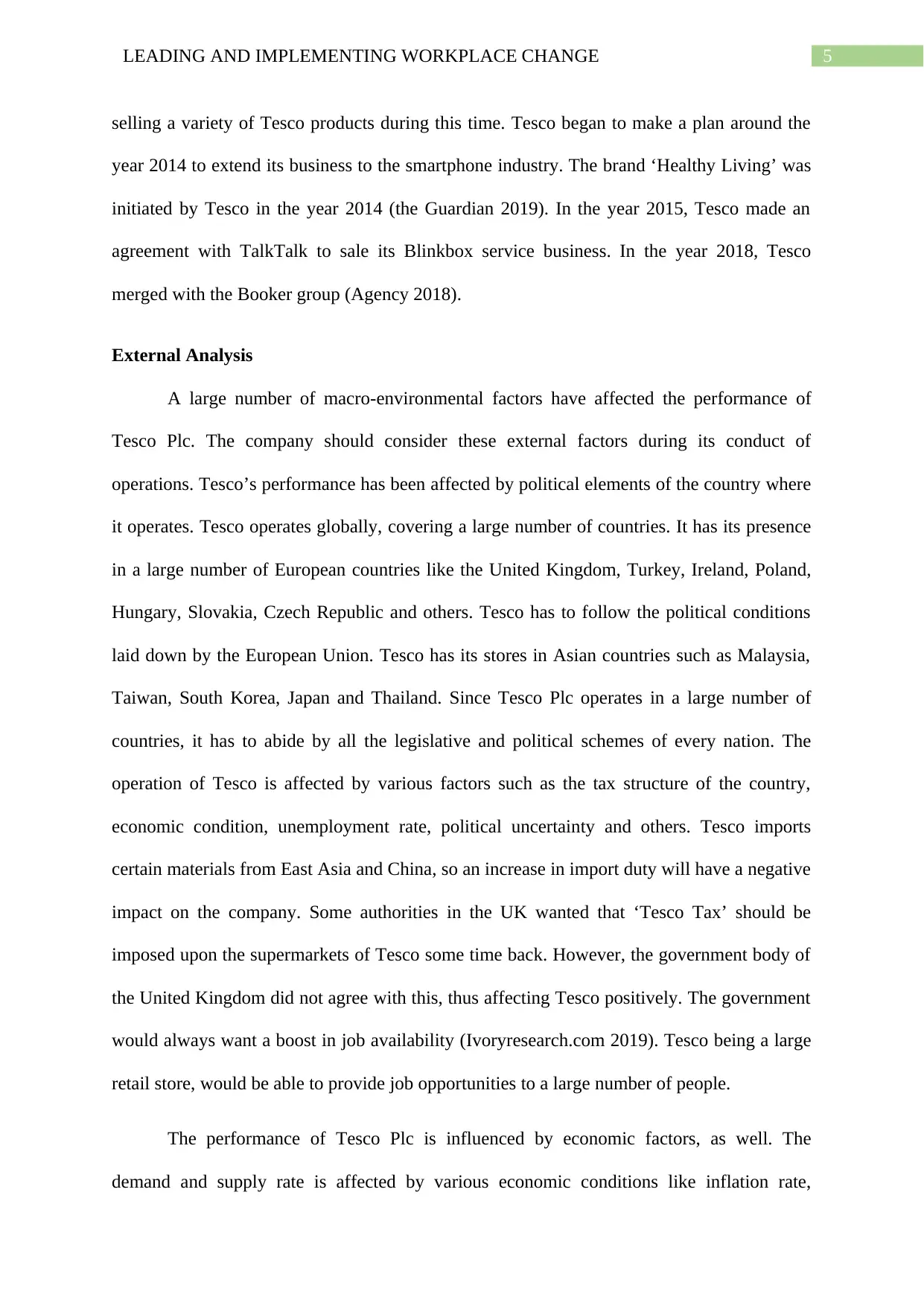
5LEADING AND IMPLEMENTING WORKPLACE CHANGE
selling a variety of Tesco products during this time. Tesco began to make a plan around the
year 2014 to extend its business to the smartphone industry. The brand ‘Healthy Living’ was
initiated by Tesco in the year 2014 (the Guardian 2019). In the year 2015, Tesco made an
agreement with TalkTalk to sale its Blinkbox service business. In the year 2018, Tesco
merged with the Booker group (Agency 2018).
External Analysis
A large number of macro-environmental factors have affected the performance of
Tesco Plc. The company should consider these external factors during its conduct of
operations. Tesco’s performance has been affected by political elements of the country where
it operates. Tesco operates globally, covering a large number of countries. It has its presence
in a large number of European countries like the United Kingdom, Turkey, Ireland, Poland,
Hungary, Slovakia, Czech Republic and others. Tesco has to follow the political conditions
laid down by the European Union. Tesco has its stores in Asian countries such as Malaysia,
Taiwan, South Korea, Japan and Thailand. Since Tesco Plc operates in a large number of
countries, it has to abide by all the legislative and political schemes of every nation. The
operation of Tesco is affected by various factors such as the tax structure of the country,
economic condition, unemployment rate, political uncertainty and others. Tesco imports
certain materials from East Asia and China, so an increase in import duty will have a negative
impact on the company. Some authorities in the UK wanted that ‘Tesco Tax’ should be
imposed upon the supermarkets of Tesco some time back. However, the government body of
the United Kingdom did not agree with this, thus affecting Tesco positively. The government
would always want a boost in job availability (Ivoryresearch.com 2019). Tesco being a large
retail store, would be able to provide job opportunities to a large number of people.
The performance of Tesco Plc is influenced by economic factors, as well. The
demand and supply rate is affected by various economic conditions like inflation rate,
selling a variety of Tesco products during this time. Tesco began to make a plan around the
year 2014 to extend its business to the smartphone industry. The brand ‘Healthy Living’ was
initiated by Tesco in the year 2014 (the Guardian 2019). In the year 2015, Tesco made an
agreement with TalkTalk to sale its Blinkbox service business. In the year 2018, Tesco
merged with the Booker group (Agency 2018).
External Analysis
A large number of macro-environmental factors have affected the performance of
Tesco Plc. The company should consider these external factors during its conduct of
operations. Tesco’s performance has been affected by political elements of the country where
it operates. Tesco operates globally, covering a large number of countries. It has its presence
in a large number of European countries like the United Kingdom, Turkey, Ireland, Poland,
Hungary, Slovakia, Czech Republic and others. Tesco has to follow the political conditions
laid down by the European Union. Tesco has its stores in Asian countries such as Malaysia,
Taiwan, South Korea, Japan and Thailand. Since Tesco Plc operates in a large number of
countries, it has to abide by all the legislative and political schemes of every nation. The
operation of Tesco is affected by various factors such as the tax structure of the country,
economic condition, unemployment rate, political uncertainty and others. Tesco imports
certain materials from East Asia and China, so an increase in import duty will have a negative
impact on the company. Some authorities in the UK wanted that ‘Tesco Tax’ should be
imposed upon the supermarkets of Tesco some time back. However, the government body of
the United Kingdom did not agree with this, thus affecting Tesco positively. The government
would always want a boost in job availability (Ivoryresearch.com 2019). Tesco being a large
retail store, would be able to provide job opportunities to a large number of people.
The performance of Tesco Plc is influenced by economic factors, as well. The
demand and supply rate is affected by various economic conditions like inflation rate,
⊘ This is a preview!⊘
Do you want full access?
Subscribe today to unlock all pages.

Trusted by 1+ million students worldwide
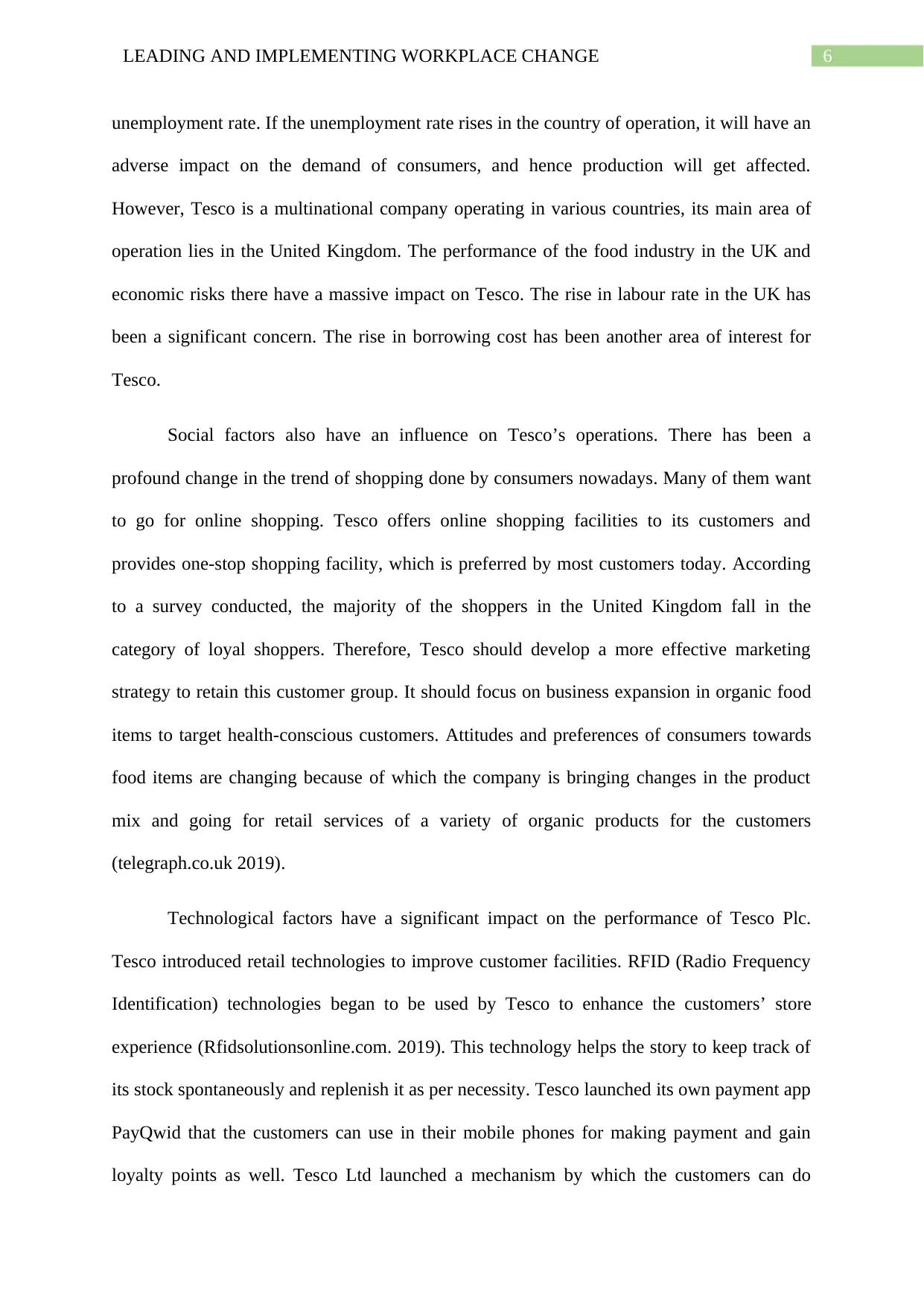
6LEADING AND IMPLEMENTING WORKPLACE CHANGE
unemployment rate. If the unemployment rate rises in the country of operation, it will have an
adverse impact on the demand of consumers, and hence production will get affected.
However, Tesco is a multinational company operating in various countries, its main area of
operation lies in the United Kingdom. The performance of the food industry in the UK and
economic risks there have a massive impact on Tesco. The rise in labour rate in the UK has
been a significant concern. The rise in borrowing cost has been another area of interest for
Tesco.
Social factors also have an influence on Tesco’s operations. There has been a
profound change in the trend of shopping done by consumers nowadays. Many of them want
to go for online shopping. Tesco offers online shopping facilities to its customers and
provides one-stop shopping facility, which is preferred by most customers today. According
to a survey conducted, the majority of the shoppers in the United Kingdom fall in the
category of loyal shoppers. Therefore, Tesco should develop a more effective marketing
strategy to retain this customer group. It should focus on business expansion in organic food
items to target health-conscious customers. Attitudes and preferences of consumers towards
food items are changing because of which the company is bringing changes in the product
mix and going for retail services of a variety of organic products for the customers
(telegraph.co.uk 2019).
Technological factors have a significant impact on the performance of Tesco Plc.
Tesco introduced retail technologies to improve customer facilities. RFID (Radio Frequency
Identification) technologies began to be used by Tesco to enhance the customers’ store
experience (Rfidsolutionsonline.com. 2019). This technology helps the story to keep track of
its stock spontaneously and replenish it as per necessity. Tesco launched its own payment app
PayQwid that the customers can use in their mobile phones for making payment and gain
loyalty points as well. Tesco Ltd launched a mechanism by which the customers can do
unemployment rate. If the unemployment rate rises in the country of operation, it will have an
adverse impact on the demand of consumers, and hence production will get affected.
However, Tesco is a multinational company operating in various countries, its main area of
operation lies in the United Kingdom. The performance of the food industry in the UK and
economic risks there have a massive impact on Tesco. The rise in labour rate in the UK has
been a significant concern. The rise in borrowing cost has been another area of interest for
Tesco.
Social factors also have an influence on Tesco’s operations. There has been a
profound change in the trend of shopping done by consumers nowadays. Many of them want
to go for online shopping. Tesco offers online shopping facilities to its customers and
provides one-stop shopping facility, which is preferred by most customers today. According
to a survey conducted, the majority of the shoppers in the United Kingdom fall in the
category of loyal shoppers. Therefore, Tesco should develop a more effective marketing
strategy to retain this customer group. It should focus on business expansion in organic food
items to target health-conscious customers. Attitudes and preferences of consumers towards
food items are changing because of which the company is bringing changes in the product
mix and going for retail services of a variety of organic products for the customers
(telegraph.co.uk 2019).
Technological factors have a significant impact on the performance of Tesco Plc.
Tesco introduced retail technologies to improve customer facilities. RFID (Radio Frequency
Identification) technologies began to be used by Tesco to enhance the customers’ store
experience (Rfidsolutionsonline.com. 2019). This technology helps the story to keep track of
its stock spontaneously and replenish it as per necessity. Tesco launched its own payment app
PayQwid that the customers can use in their mobile phones for making payment and gain
loyalty points as well. Tesco Ltd launched a mechanism by which the customers can do
Paraphrase This Document
Need a fresh take? Get an instant paraphrase of this document with our AI Paraphraser

7LEADING AND IMPLEMENTING WORKPLACE CHANGE
tagging of products while shopping. It helps to reduce the cost of labour along with saving
time. Tesco uses the self-checkout machine system. It also introduced the ECR (Efficient
Consumer Response) system. The distribution system of Tesco has dramatically improved by
its adoption of the Electronic Fund Transfer System and Electronic Point of Scale.
Companies have to conduct corporate social responsibilities to build the right image
among the customers. Tesco is taking up steps to ensure that it minimises energy
consumption and does not emit greenhouse gases. Tesco has taken up the responsibility of
recycling plastic bags. It is inclined towards the use of various types of renewable resources
and intends to lower down the carbon footprint (Telegraph.co.uk 2019). Many countries in
Europe provide some tax benefits to those organisations, which adopt eco-friendly strategies.
Tesco has developed various ways to benefit society. Being in the retail sector, Tesco has an
excellent waste management system and contributes towards minimising environmental
pollution.
A number of statutory factors influence the activities of Tesco. The performance of a
business is affected by changes in the law system. Various policies and regulations of each
country affect Tesco’s performance. Tesco being in the retail industry, has to abide by the
policies set up Food Retailing Commission. Tesco had also experienced some legal action
due to some unfair practices regarding accounting and misguiding the shareholders. In the
year 2016, there was grievance among employees of Tesco about the issue of them facing
discrimination based on age as well as gender. Tesco has to take account of the
discrimination law. It should consider safety law and health law as well. It has to conduct its
operations by taking consumer protection laws into account.
tagging of products while shopping. It helps to reduce the cost of labour along with saving
time. Tesco uses the self-checkout machine system. It also introduced the ECR (Efficient
Consumer Response) system. The distribution system of Tesco has dramatically improved by
its adoption of the Electronic Fund Transfer System and Electronic Point of Scale.
Companies have to conduct corporate social responsibilities to build the right image
among the customers. Tesco is taking up steps to ensure that it minimises energy
consumption and does not emit greenhouse gases. Tesco has taken up the responsibility of
recycling plastic bags. It is inclined towards the use of various types of renewable resources
and intends to lower down the carbon footprint (Telegraph.co.uk 2019). Many countries in
Europe provide some tax benefits to those organisations, which adopt eco-friendly strategies.
Tesco has developed various ways to benefit society. Being in the retail sector, Tesco has an
excellent waste management system and contributes towards minimising environmental
pollution.
A number of statutory factors influence the activities of Tesco. The performance of a
business is affected by changes in the law system. Various policies and regulations of each
country affect Tesco’s performance. Tesco being in the retail industry, has to abide by the
policies set up Food Retailing Commission. Tesco had also experienced some legal action
due to some unfair practices regarding accounting and misguiding the shareholders. In the
year 2016, there was grievance among employees of Tesco about the issue of them facing
discrimination based on age as well as gender. Tesco has to take account of the
discrimination law. It should consider safety law and health law as well. It has to conduct its
operations by taking consumer protection laws into account.
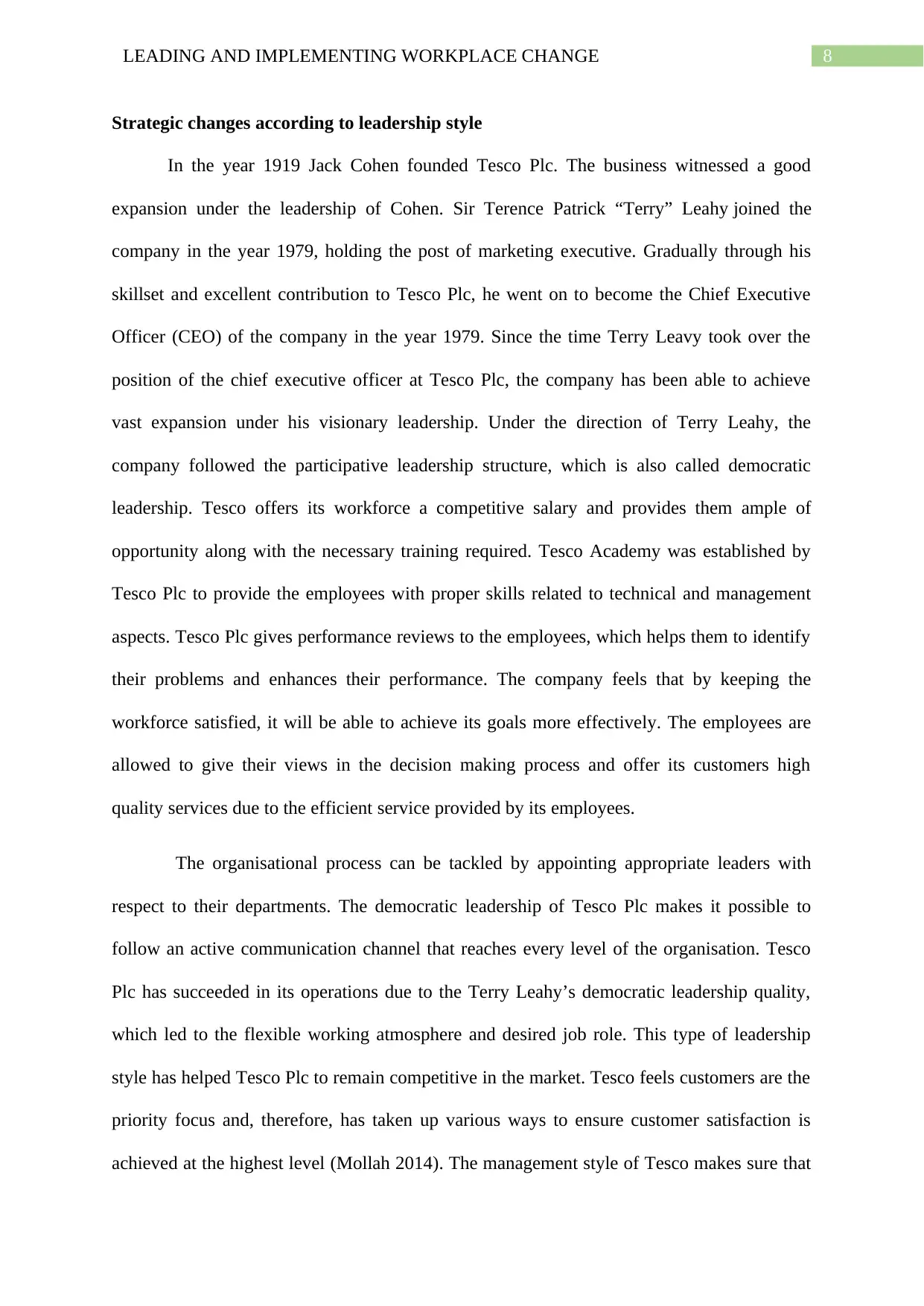
8LEADING AND IMPLEMENTING WORKPLACE CHANGE
Strategic changes according to leadership style
In the year 1919 Jack Cohen founded Tesco Plc. The business witnessed a good
expansion under the leadership of Cohen. Sir Terence Patrick “Terry” Leahy joined the
company in the year 1979, holding the post of marketing executive. Gradually through his
skillset and excellent contribution to Tesco Plc, he went on to become the Chief Executive
Officer (CEO) of the company in the year 1979. Since the time Terry Leavy took over the
position of the chief executive officer at Tesco Plc, the company has been able to achieve
vast expansion under his visionary leadership. Under the direction of Terry Leahy, the
company followed the participative leadership structure, which is also called democratic
leadership. Tesco offers its workforce a competitive salary and provides them ample of
opportunity along with the necessary training required. Tesco Academy was established by
Tesco Plc to provide the employees with proper skills related to technical and management
aspects. Tesco Plc gives performance reviews to the employees, which helps them to identify
their problems and enhances their performance. The company feels that by keeping the
workforce satisfied, it will be able to achieve its goals more effectively. The employees are
allowed to give their views in the decision making process and offer its customers high
quality services due to the efficient service provided by its employees.
The organisational process can be tackled by appointing appropriate leaders with
respect to their departments. The democratic leadership of Tesco Plc makes it possible to
follow an active communication channel that reaches every level of the organisation. Tesco
Plc has succeeded in its operations due to the Terry Leahy’s democratic leadership quality,
which led to the flexible working atmosphere and desired job role. This type of leadership
style has helped Tesco Plc to remain competitive in the market. Tesco feels customers are the
priority focus and, therefore, has taken up various ways to ensure customer satisfaction is
achieved at the highest level (Mollah 2014). The management style of Tesco makes sure that
Strategic changes according to leadership style
In the year 1919 Jack Cohen founded Tesco Plc. The business witnessed a good
expansion under the leadership of Cohen. Sir Terence Patrick “Terry” Leahy joined the
company in the year 1979, holding the post of marketing executive. Gradually through his
skillset and excellent contribution to Tesco Plc, he went on to become the Chief Executive
Officer (CEO) of the company in the year 1979. Since the time Terry Leavy took over the
position of the chief executive officer at Tesco Plc, the company has been able to achieve
vast expansion under his visionary leadership. Under the direction of Terry Leahy, the
company followed the participative leadership structure, which is also called democratic
leadership. Tesco offers its workforce a competitive salary and provides them ample of
opportunity along with the necessary training required. Tesco Academy was established by
Tesco Plc to provide the employees with proper skills related to technical and management
aspects. Tesco Plc gives performance reviews to the employees, which helps them to identify
their problems and enhances their performance. The company feels that by keeping the
workforce satisfied, it will be able to achieve its goals more effectively. The employees are
allowed to give their views in the decision making process and offer its customers high
quality services due to the efficient service provided by its employees.
The organisational process can be tackled by appointing appropriate leaders with
respect to their departments. The democratic leadership of Tesco Plc makes it possible to
follow an active communication channel that reaches every level of the organisation. Tesco
Plc has succeeded in its operations due to the Terry Leahy’s democratic leadership quality,
which led to the flexible working atmosphere and desired job role. This type of leadership
style has helped Tesco Plc to remain competitive in the market. Tesco feels customers are the
priority focus and, therefore, has taken up various ways to ensure customer satisfaction is
achieved at the highest level (Mollah 2014). The management style of Tesco makes sure that
⊘ This is a preview!⊘
Do you want full access?
Subscribe today to unlock all pages.

Trusted by 1+ million students worldwide

9LEADING AND IMPLEMENTING WORKPLACE CHANGE
proper communication is established between the company and its customers so that the
company takes the customers’ views into account. Tesco thinks that having negotiations will
be another way to solve the problems. It seeks ways to ensure that it maintains a healthy and
cordial relationship between the employees and the company and helps to resolve the conflict
in case if it arises (Jenkins and Williamson 2015). Tesco believes in addressing the
complaints by the customers. It works to enhance customer welfare. Terry Leah focussed on
developing leadership skills in all the departments of the organisation. He has followed the
system of flat management style in order to empower every individual associated with the
company. He never supported the idea of having a single leader, which he believed would
lead to autocratic leadership in the organisation. Tesco Plc also adopted local leadership as it
found it suitable for the customers. The company has always followed a realistic approach
with dedication to ensure that the goals are attained. The company follows such a business
policy, which provides that the products are sold at an affordable price without hampering the
quality.
Due to flexible leadership style, Tesco Plc has been able to expand its business to
other parts of the world and establish itself as a famous multinational company. Besides this,
the company has now started its business in a variety of non-food product items other than
the food products. It had launched superstores by the brand name Fresh and Easy when it
entered the US. Tesco Plc took ways to give incentive points to the customers through a
loyalty card known as Tesco Clubcard. Tesco has always thought ahead of time. Back in the
year 1995, Tesco launched an online shopping service to its customers. In the year 2006,
Tesco entered the telecommunication industry by doing a business venture with O2. After
that, it launched mobile phones. It conducts its telecom operations in Ireland, Slovakia and
the United Kingdom. It offers telecom service to its customers at a low rate and expanded its
business area by giving insurance facilities to its customers at a flat rate as a way of thanking
proper communication is established between the company and its customers so that the
company takes the customers’ views into account. Tesco thinks that having negotiations will
be another way to solve the problems. It seeks ways to ensure that it maintains a healthy and
cordial relationship between the employees and the company and helps to resolve the conflict
in case if it arises (Jenkins and Williamson 2015). Tesco believes in addressing the
complaints by the customers. It works to enhance customer welfare. Terry Leah focussed on
developing leadership skills in all the departments of the organisation. He has followed the
system of flat management style in order to empower every individual associated with the
company. He never supported the idea of having a single leader, which he believed would
lead to autocratic leadership in the organisation. Tesco Plc also adopted local leadership as it
found it suitable for the customers. The company has always followed a realistic approach
with dedication to ensure that the goals are attained. The company follows such a business
policy, which provides that the products are sold at an affordable price without hampering the
quality.
Due to flexible leadership style, Tesco Plc has been able to expand its business to
other parts of the world and establish itself as a famous multinational company. Besides this,
the company has now started its business in a variety of non-food product items other than
the food products. It had launched superstores by the brand name Fresh and Easy when it
entered the US. Tesco Plc took ways to give incentive points to the customers through a
loyalty card known as Tesco Clubcard. Tesco has always thought ahead of time. Back in the
year 1995, Tesco launched an online shopping service to its customers. In the year 2006,
Tesco entered the telecommunication industry by doing a business venture with O2. After
that, it launched mobile phones. It conducts its telecom operations in Ireland, Slovakia and
the United Kingdom. It offers telecom service to its customers at a low rate and expanded its
business area by giving insurance facilities to its customers at a flat rate as a way of thanking
Paraphrase This Document
Need a fresh take? Get an instant paraphrase of this document with our AI Paraphraser
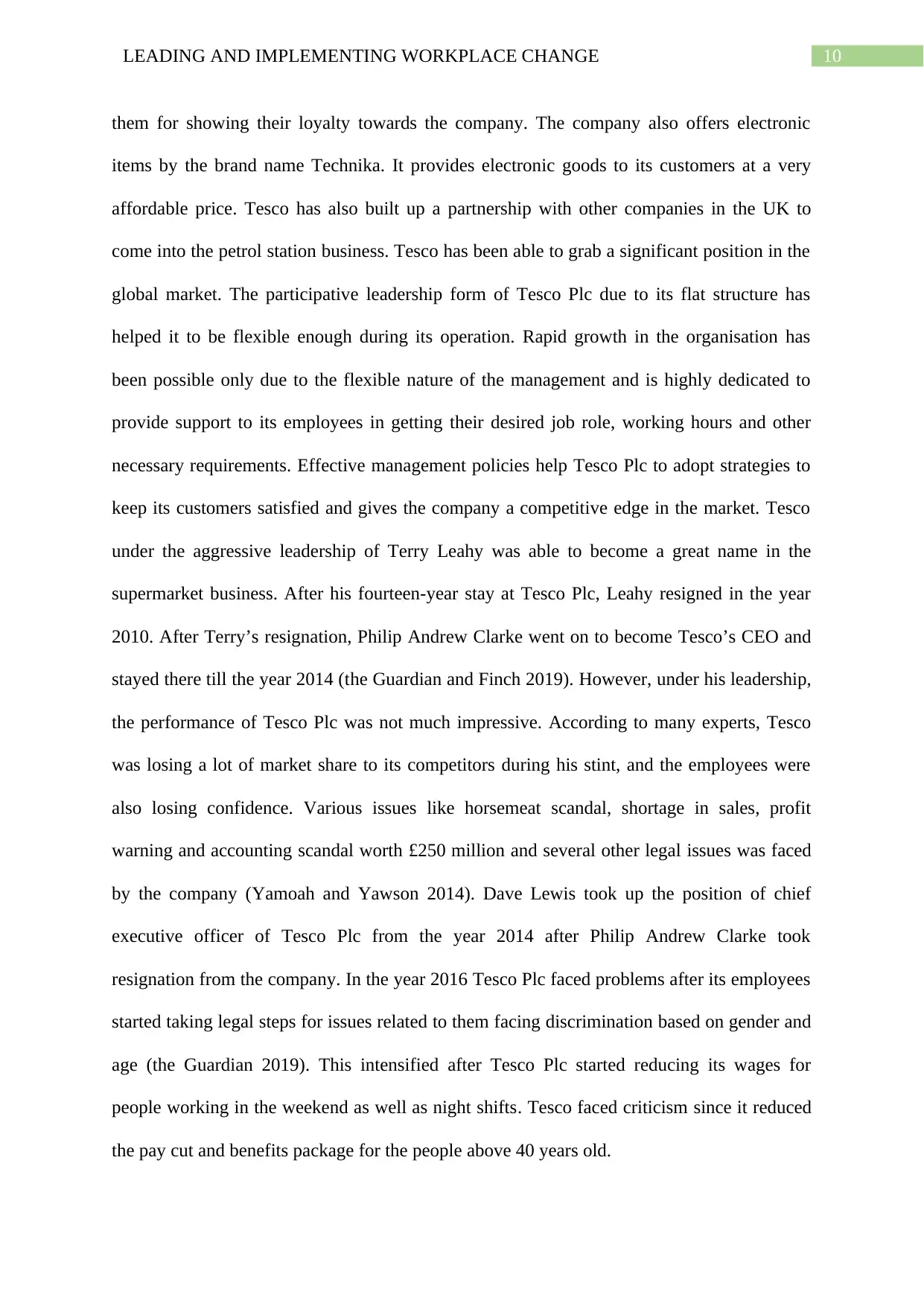
10LEADING AND IMPLEMENTING WORKPLACE CHANGE
them for showing their loyalty towards the company. The company also offers electronic
items by the brand name Technika. It provides electronic goods to its customers at a very
affordable price. Tesco has also built up a partnership with other companies in the UK to
come into the petrol station business. Tesco has been able to grab a significant position in the
global market. The participative leadership form of Tesco Plc due to its flat structure has
helped it to be flexible enough during its operation. Rapid growth in the organisation has
been possible only due to the flexible nature of the management and is highly dedicated to
provide support to its employees in getting their desired job role, working hours and other
necessary requirements. Effective management policies help Tesco Plc to adopt strategies to
keep its customers satisfied and gives the company a competitive edge in the market. Tesco
under the aggressive leadership of Terry Leahy was able to become a great name in the
supermarket business. After his fourteen-year stay at Tesco Plc, Leahy resigned in the year
2010. After Terry’s resignation, Philip Andrew Clarke went on to become Tesco’s CEO and
stayed there till the year 2014 (the Guardian and Finch 2019). However, under his leadership,
the performance of Tesco Plc was not much impressive. According to many experts, Tesco
was losing a lot of market share to its competitors during his stint, and the employees were
also losing confidence. Various issues like horsemeat scandal, shortage in sales, profit
warning and accounting scandal worth £250 million and several other legal issues was faced
by the company (Yamoah and Yawson 2014). Dave Lewis took up the position of chief
executive officer of Tesco Plc from the year 2014 after Philip Andrew Clarke took
resignation from the company. In the year 2016 Tesco Plc faced problems after its employees
started taking legal steps for issues related to them facing discrimination based on gender and
age (the Guardian 2019). This intensified after Tesco Plc started reducing its wages for
people working in the weekend as well as night shifts. Tesco faced criticism since it reduced
the pay cut and benefits package for the people above 40 years old.
them for showing their loyalty towards the company. The company also offers electronic
items by the brand name Technika. It provides electronic goods to its customers at a very
affordable price. Tesco has also built up a partnership with other companies in the UK to
come into the petrol station business. Tesco has been able to grab a significant position in the
global market. The participative leadership form of Tesco Plc due to its flat structure has
helped it to be flexible enough during its operation. Rapid growth in the organisation has
been possible only due to the flexible nature of the management and is highly dedicated to
provide support to its employees in getting their desired job role, working hours and other
necessary requirements. Effective management policies help Tesco Plc to adopt strategies to
keep its customers satisfied and gives the company a competitive edge in the market. Tesco
under the aggressive leadership of Terry Leahy was able to become a great name in the
supermarket business. After his fourteen-year stay at Tesco Plc, Leahy resigned in the year
2010. After Terry’s resignation, Philip Andrew Clarke went on to become Tesco’s CEO and
stayed there till the year 2014 (the Guardian and Finch 2019). However, under his leadership,
the performance of Tesco Plc was not much impressive. According to many experts, Tesco
was losing a lot of market share to its competitors during his stint, and the employees were
also losing confidence. Various issues like horsemeat scandal, shortage in sales, profit
warning and accounting scandal worth £250 million and several other legal issues was faced
by the company (Yamoah and Yawson 2014). Dave Lewis took up the position of chief
executive officer of Tesco Plc from the year 2014 after Philip Andrew Clarke took
resignation from the company. In the year 2016 Tesco Plc faced problems after its employees
started taking legal steps for issues related to them facing discrimination based on gender and
age (the Guardian 2019). This intensified after Tesco Plc started reducing its wages for
people working in the weekend as well as night shifts. Tesco faced criticism since it reduced
the pay cut and benefits package for the people above 40 years old.
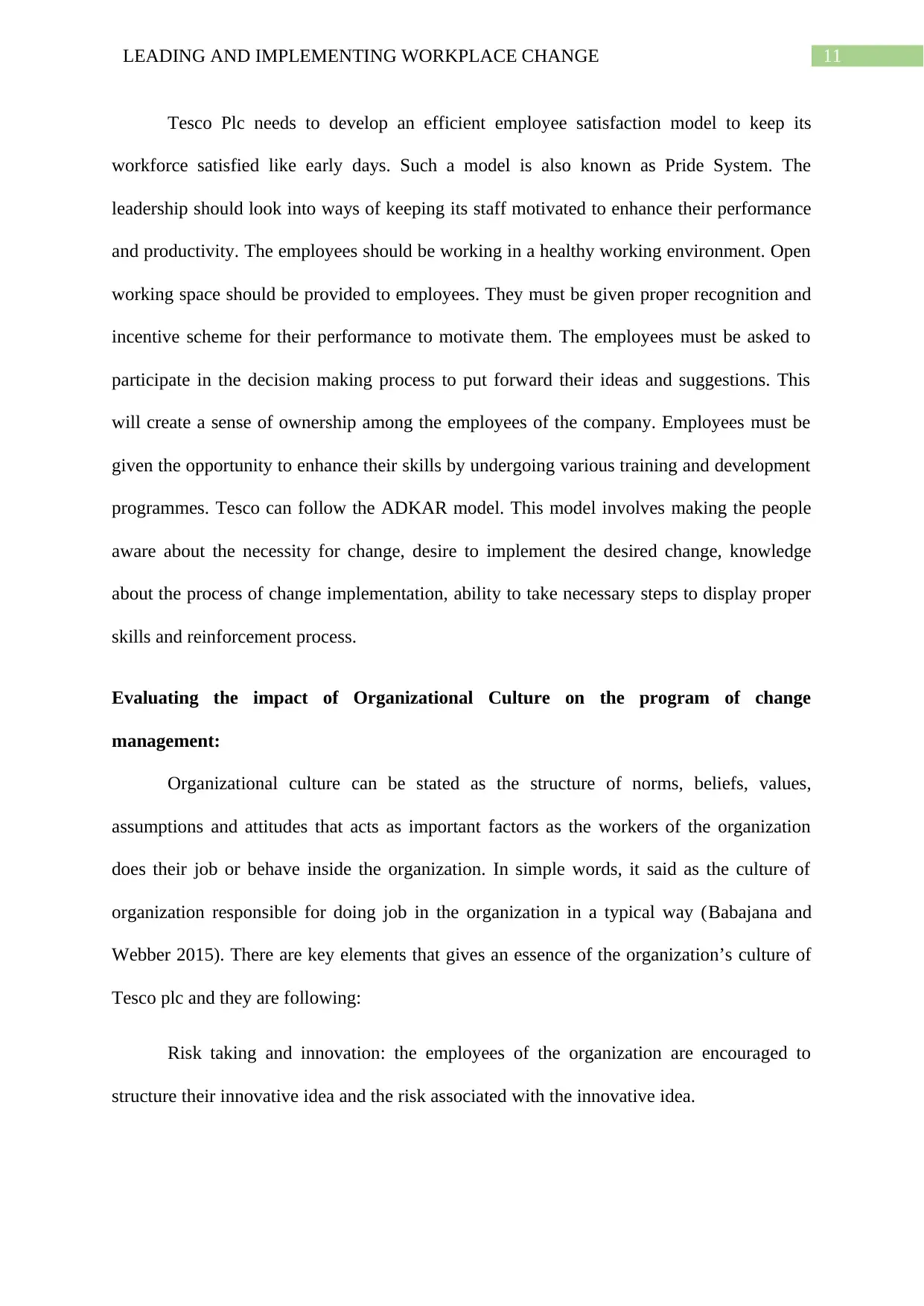
11LEADING AND IMPLEMENTING WORKPLACE CHANGE
Tesco Plc needs to develop an efficient employee satisfaction model to keep its
workforce satisfied like early days. Such a model is also known as Pride System. The
leadership should look into ways of keeping its staff motivated to enhance their performance
and productivity. The employees should be working in a healthy working environment. Open
working space should be provided to employees. They must be given proper recognition and
incentive scheme for their performance to motivate them. The employees must be asked to
participate in the decision making process to put forward their ideas and suggestions. This
will create a sense of ownership among the employees of the company. Employees must be
given the opportunity to enhance their skills by undergoing various training and development
programmes. Tesco can follow the ADKAR model. This model involves making the people
aware about the necessity for change, desire to implement the desired change, knowledge
about the process of change implementation, ability to take necessary steps to display proper
skills and reinforcement process.
Evaluating the impact of Organizational Culture on the program of change
management:
Organizational culture can be stated as the structure of norms, beliefs, values,
assumptions and attitudes that acts as important factors as the workers of the organization
does their job or behave inside the organization. In simple words, it said as the culture of
organization responsible for doing job in the organization in a typical way (Babajana and
Webber 2015). There are key elements that gives an essence of the organization’s culture of
Tesco plc and they are following:
Risk taking and innovation: the employees of the organization are encouraged to
structure their innovative idea and the risk associated with the innovative idea.
Tesco Plc needs to develop an efficient employee satisfaction model to keep its
workforce satisfied like early days. Such a model is also known as Pride System. The
leadership should look into ways of keeping its staff motivated to enhance their performance
and productivity. The employees should be working in a healthy working environment. Open
working space should be provided to employees. They must be given proper recognition and
incentive scheme for their performance to motivate them. The employees must be asked to
participate in the decision making process to put forward their ideas and suggestions. This
will create a sense of ownership among the employees of the company. Employees must be
given the opportunity to enhance their skills by undergoing various training and development
programmes. Tesco can follow the ADKAR model. This model involves making the people
aware about the necessity for change, desire to implement the desired change, knowledge
about the process of change implementation, ability to take necessary steps to display proper
skills and reinforcement process.
Evaluating the impact of Organizational Culture on the program of change
management:
Organizational culture can be stated as the structure of norms, beliefs, values,
assumptions and attitudes that acts as important factors as the workers of the organization
does their job or behave inside the organization. In simple words, it said as the culture of
organization responsible for doing job in the organization in a typical way (Babajana and
Webber 2015). There are key elements that gives an essence of the organization’s culture of
Tesco plc and they are following:
Risk taking and innovation: the employees of the organization are encouraged to
structure their innovative idea and the risk associated with the innovative idea.
⊘ This is a preview!⊘
Do you want full access?
Subscribe today to unlock all pages.

Trusted by 1+ million students worldwide
1 out of 23
Related Documents
Your All-in-One AI-Powered Toolkit for Academic Success.
+13062052269
info@desklib.com
Available 24*7 on WhatsApp / Email
![[object Object]](/_next/static/media/star-bottom.7253800d.svg)
Unlock your academic potential
Copyright © 2020–2025 A2Z Services. All Rights Reserved. Developed and managed by ZUCOL.





